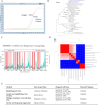Era of molecular diagnosis for pathogen identification of unexplained pneumonia, lessons to be learned
- PMID: 32174267
- PMCID: PMC7144283
- DOI: 10.1080/22221751.2020.1738905
Era of molecular diagnosis for pathogen identification of unexplained pneumonia, lessons to be learned
Abstract
Unexplained pneumonia (UP) caused by a novel coronavirus SARS-CoV-2 (severe acute respiratory syndrome coronavirus 2) emerged in China in late December 2019 and has infected more than 9000 cases by 31 January 2020. Shanghai reported the first imported case of COVID-19 (Coronavirus Disease 2019) in 20 January 2020. A combinative approach of real-time RT-PCR, CRISPR-based assay and metagenomic next-generation sequencing (mNGS) were used to diagnose this unexplained pneumonia patient. Real-time RT-PCR and CRISPR-based assay both reported positive. This sample belonged to Betacoronavirus and shared a more than 99% nucleotide (nt) identity with the Wuhan SARS-CoV-2 isolates. We further compared pros and cons of common molecular diagnostics in UP. In this study, we illustrated the importance of combining molecular diagnostics to rule out common pathogens and performed mNGS to obtain unbiased potential pathogen result for the diagnosis of UP.
Keywords: COVID-19; SARS-CoV-2; Unexplained pneumonia; diagnosis; molecular.
Conflict of interest statement
No potential conflict of interest was reported by the author(s).
Figures

References
-
- Juan D. Wuhan wet market closes amid pneumonia outbreak. China Daily, 2020 Jan 1. Available from: https://www.chinadaily.com.cn/a/202001/01/WS5e0c6a49a310cf3e35581e30.html.
-
- [cited 2020 Jan 31]. Available from: https://3g.dxy.cn/newh5/view/pneumonia?scene=2&clicktime=1579582238&ente....
Publication types
MeSH terms
Substances
LinkOut - more resources
Full Text Sources
Other Literature Sources
Medical
Research Materials
Miscellaneous
